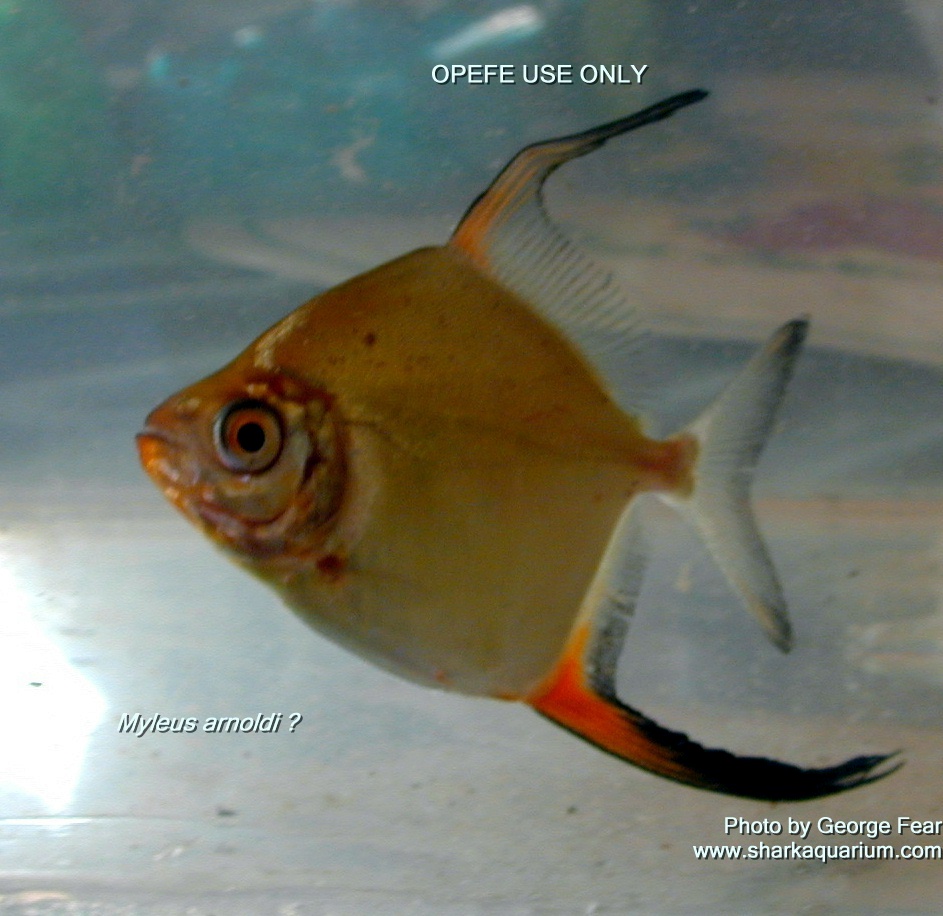 WELCOME TO OPEFE ARCHIVES
WELCOME TO OPEFE ARCHIVESGenus Myleus
(Müller and Troschel 1845)
Common Names: Red Hook Myleus (Red Hook Metynnis).
FROM FRANK MAGALLANES
This species, besides being an aquarium fish favorites is found in tropical America. This species complex is widely distributed in lowland areas of South America east of the Andes, including the Amazon, Orinoco, and Parańa (Paraguay River) basins and various coastal drainages of the Guiana's (Géry 1977). The species grows to about 15 cm SL and is a food items for natives.
VALID SPECIES LIST 2011
|
Myleus altipinnis Valenciennes 1850
Săo Franciso River basin, Brazil
|
Myleus arnoldi Ahl 1936
Amazon, Xingu and Tocantins River basins, Brazil
|
Myleus knerii Steindachner 1881
Maroni River basin, French Guiana
|
Myleus levis Eigenmann & McAtee 1907
Paraguay-Paraná River basin: Brazil and Paraguay
|
Myleus lobatus Valenciennes 1850
Amazon and Orinoco River basins: Brazil, Peru and Venezuela
|
|
Myleus micans Lütken 1875
Săo Francisco River basin, Brazil
|
Myleus pacu Jardine 1841
Essequibo River, Guyana
|
Myleus rhomboidalis Cuvier 1818
Amazon River basin and northern and eastern Guiana Shield rivers: Brazil, French Guiana, Guyana, Suriname and Venezuela
|
Myleus schomburgkii Jardine 1841
Middle and lower Amazon River basin, Nanay River, upper Orinoco River basin: Brazil, Peru, Suriname (?) and Venezuela
|
Myleus setiger Müller & Troschel 1844
Tributaries of lower and middle Amazon River basin, orinoco River basin, upper Orinoco River and tributaries, and northern and eastern Guiana Shield rivers: Brazil, Guyana, Suriname and Venezuela |
|
Myleus ternetzi Norman 1929
French Guiana
|
Myleus torquatus Kner 1858
Amazon, Negro and Orinoco River basins: Brazil and Venezuela |
|
|
|
Leydig cells in Myleus ternetzi testes
Maurice
Loir, Anne Margeridon and Chantal Cauty
INRA, Physiologie des Poissons, Campus de Beaulieu, 35042 Rennes Cedex, France
(Received 2 September 1988, Accepted 18 January 1989).
ABSTRACT
Males of Myleus ternetzi, at various maturation stages were netted in a
French Guyana river. Testes were histologically and ultrastructurally analysed.
Leydig cells were always present in large numbers. In mature or almost mature
testes, they were characterized by a large spherical nucleus and an extensively
developed smooth endoplasmic reticulum (SER) composed of very narrow tightly
packed tubules. In regressed testes, most of the Leydig cells had a smaller
nucleus with an irregular shape, a disorganized SER and the fine structure of
the mitochondria was greatly affected. These changes would reflect
different phases throughout a metabolic cycle in relation to spermatogenesis.
REFERENCES
THATCHER, V.E., SEY, O. & M. JÉGU, 1996.- New Amphistome (Trematoda) genera and species from Serrasalmid fishes, Myleus (Myloplus). Acta Zool. Acad. Scientia. Hung. 42(4): 261-270.
JÉGU, M., 2001 Description complémentaire du type de Myloplus schulzei Ahl, 1938 (Characiformes: Characidae: Serrasalminae) et statut de l'espčce. Cybium, 25(4):
JÉGU, M. & G.M. dos SANTOS, 2002. Révision du statut de Myleus setiger Müller & Troschel, 1844 et de Myleus knerii (Steindachner, 1881) (Teleostei: Characidae: Serrasalminae) avec une description complémentaire des deux espčces. Cybium. 26(1): 33-57.
Géry, J., 1977. Characoids of the world.. T.F.H. Publications, Inc., N.J. pg: 672 (262-263), p: 665
Froese, R. and D. Pauly. Editors. 2002. FishBase.World Wide Web electronic publication. www.fishbase.org 13 November 2002
USE YOUR BACKSPACE TO RETURN OR CLICK HERE TO RETURN VALID SPECIES PHYTOPHAGOUS PAGE
USE THIS LINK TO RETURN TO RESEARCH PAGE.
TO RETURN HOME CLICK HERE.
The OPEFE web site and its contents; is disclaimed for purposes of Zoological Nomenclature in accordance with the International Code of Zoological Nomenclature, Fourth Edition, Article 8.3 and 8.4. No new names or nomenclature changes are available from statements at this web site.
Copyright© 1994-20012 Oregon Piranha Exotic Fish Exhibit (The OPEFE fish exhibit is permanently CLOSED as of 2000) Sutherlin, Oregon. Information posted on this web site is archival data on fish scientific classifications and other information. DISCLAIMER: The copyrighted material may not be used for any purpose other than private study, scholarship or research. Cited information requires credit and this link www.opefe.com. All rights reserved. All images shown (unless otherwise noted) is property of OPEFE.
UPDATED: 12/28/2011